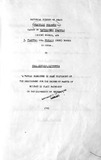| dc.description.abstract | Xanthomonas phaseoli (Smith) Dowson, and X, phaseo1i var. fuscans (Burk) Dowson were isolated from blighted bean plants collected during a survey in small scale farms in Kenya. Common and fuscous blights of beans were prevalent in all bean growing areas, but reached epidemic proportions in a few areas such as Meru, Kitui, Machakos, Kakaraega, Embu, Trans-nzoia and Muranga. Common blight was severe in Meru with 12.9% incidence; Machakos, 11.0% and Kiambu and Muranga with 9.6% incidences each. Fuscous blight had higher incidences in Meru, 16.7%; Machakos, 12.0% and Kiambu and Muranga 9.6% each. In 54 small scale farms surveyed, the Incidence of fuscous blight was 90.7% and that of common blight 83.3%.
The symptoms of common and fuscous blight of beans were found similar, leaves and pods showed water soaked spots in all cases. Common and fuscous blight showed irregular necrotic patches surrounded by yellow to brown margins. Brick-red longitudinal lesions were found on stems with water soaking at the nodes. Greenhouse symptoms were similar to those in the field except minor differences in ‘Mwezi-moja’ and 'Contender* beans. Isolates of X. Phaseoli var.
fuscans caused small pinhole lesions on the undersurface of the leaves of ‘Mwezi-moJa’• The leaves were distorted and had chlorotic lesions. On ‘Mwezi-moja’, X. phaseoli caused large Irregular watersoaked lesions on the undersurface of the leaves and chlorosis, covering the whole leaf on the upper surfaces. On ‘Contender1’, X. phaseoli var. fuscans produced small necrotic lesions, that were raised and clustered together In a small area with no water soaking, but X. phaseoli produced dark, green water soaked flat lesions on the pods.
The Identity of X. phaseoli var. fuscans was confirmed by the production of a brown pigment on nutrient agar, while X. Phaseoli produced a yellow pigment.
The host-range of Xanthomonas phaseoli included Dollchos lablab. Phaseolus vulgaris,and P. lunatus: and that of X. Phaseoli var. fuscans was restricted to lablab. P. vulgaris P. lunatus and Vigna unquiculata.
Out of the 96 bean entries, tested for susceptibility to Xanthomonas phaseoli and X. phaseoli var. fuscans. only 12 were identified as resistant. The following entries possessed resistance to X. phaseoli: NB 107, NB 116, NB 178, NB 207, NB 1154, NB 1208, NB 1362, NB 2306, and GLP x 92* Resistance to X. phaseoli var fuscans was found in NB 107, NB 116, NB 134, NB 178, NB 207 NB 1154, NB 1208, NB 1362, NB 2234 and NB 2306.
Control measures recommended for common and fuscous blight of beans were crop rotation, use of certified seed and growing of resistant varieties. | |

